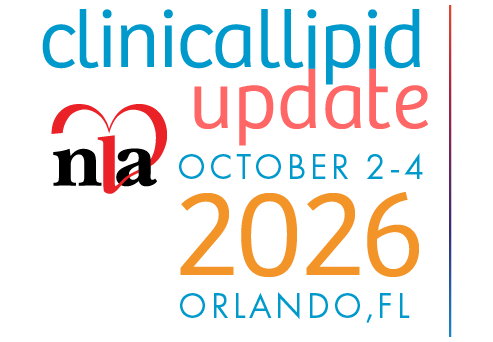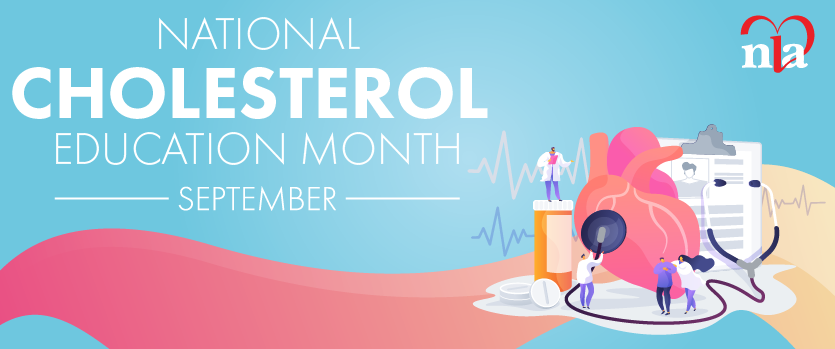Heterozygous familial hypercholesterolemia (HeFH) is an autosomal co-dominant genetic disorder, affecting roughly 1 in 220 people; characterized by lifelong elevated levels of LDL cholesterol (LDL-C) and thus predisposing to development of premature atherosclerotic cardiovascular disease (ASCVD).1-3 HeFH is the most common life-threatening inherited metabolic condition in humans. Data indicates that a child with FH is born every minute of every day! Worldwide, data also indicates that < 10% of individuals with FH have been identified.4 In the absence of early identification and effective treatment, individuals with HeFH have approximately a 10-20 fold increased-risk for premature ASCVD.4,5 Those with homozygous FH can develop ASCVD-related events during childhood, and without early and aggressive treatment, survival beyond 30 years-of-age is rare.6
When an adult is identified with HeFH, lipid-lowering medication can be effectively utilized to prevent premature CVD events. It is critically important that family members, including children, are encouraged to undergo cascade, or reverse cascade screening to identify relatives who may also have HeFH, which confers higher risk of ASCVD. Studies have shown that cascade screening identifies approximately two new cases of HeFH for each index case7 and is very cost effective. By identifying more individuals with HeFH, early education and implementation of safe and effective treatment can prevent or significantly diminish ASCVD-related morbidity and premature mortality.
HeFH is a Pediatric Disease
Prompt diagnosis and treatment of HeFH in affected children is essential in preventing ASCVD. Lifelong elevation of LDL-C in children with HeFH results in endothelial dysfunction and inflammation, which increases carotid intima media thickness (cIMT) when compared to their unaffected siblings.8 Such changes are reversible with lipid lowering therapy, such as statins. In 2004, a study of 214 pediatric patients with HeFH treated for 2 years with a fat-restricted diet, daily physical activity and pravastatin found significant reduction in their LDL-C and regression of cIMT compared to those in the placebo arm.9 Similarly, a 2002 study found that simvastatin significantly improved flow-mediated dilation of the brachial artery, a surrogate marker for endothelial function, in children with FH compared to placebo.10 Most significantly, adults with HeFH who were treated for 20 years with pravastatin, which was first initiated during childhood, were shown to have decreased progression of cIMT and dramatically fewer ASCVD events compared to their affected parents who grew up in the pre-statin era.11
Despite these encouraging results, many clinicians remain hesitant to prescribe statins to children, primarily due to safety concerns. However, statins are not only efficacious when initiated at an early age but have shown to be well tolerated and safe. Statin associated myopathy is rare in children, and there have been no reports of abnormal growth, development, or reproductive function in the setting of early statin use. Nonetheless it is important to be aware of potential statin-related adverse effects including those involving the liver (transaminitis) and muscle (elevated creatinine kinase, rarely leading to rhabdomyolysis). Short- and intermediate-term studies consistently show effective LDL-C reduction and minimal side effects.1,3,12-16 Those who question the safety of statins in children have raised concerns about altered pubertal development, onset of menses, or testicular volume; yet ample studies have shown no differences between children who are treated with statins versus those who are not.9 Based on current evidence, the National Lipid Association1, American Academy of Pediatrics17, American Heart Association13, European Atherosclerosis Society12, and International FH Foundation3, all recommend statins as first-line treatment of children with HeFH beginning as early as 8 years-of age. European guidelines for very high-risk patients recommend initial therapy starting at 5 years-of-age.
How to Diagnose Children with FH
Several sets of criteria have been developed to aid in the diagnosis of HeFH. However, most were developed primarily for adults and so their use in children was limited (see Table 1). All criteria rely on an elevated LDL-C and many include family history and physical exam findings associated with high cholesterol (e.g., arcus cornealis or tendinous xanthomas). The latter are extraordinarily rare in children with HeFH and generally only found in children with rare lipid disorders such as homozygous or compound heterozygous FH, cerebrotendinous xanthomatosis (CTX), or sitosterolemia. The wider use of lipid lowering treatments in adults also make such findings less likely in affected parents.

The American Heart Association endorses clinical criteria for the diagnosis of HeFH in children. In the absence of secondary causes of hypercholesterolemia, a child is considered to have FH with the following:
- LDL-C ≥ 160 mg/dL + a family history of elevated cholesterol or premature ASCVD in a parent or grandparent; or
- LDL-C ≥ 190 mg/dL irrespective of family history.18 Of note, in the setting of a parent with genetically confirmed FH, a child with LDL-C ≥ 130 mg/dL can be considered to have HeFH by criteria outlined by the European Atherosclerosis Society.2
Genetic testing, currently recommended for all children with a clinical diagnosis of FH, is helpful but not necessary for either diagnosis or treatment of HeFH.19 In the absence of a secondary cause, a child with an LDL-C persistently ≥ 160 mg/dL, and certainly ≥ 190 mg/dL, is most likely to have HeFH and should be treated as such. However, prior to starting treatment, it is critical to screen for secondary causes of elevated LDL-C. In addition to other health conditions, such as abnormalities of the thyroid, liver and kidney, medications can also cause cholesterol elevation (see the 2018 AHA/ACC Multisociety Guidelines for Management of Cholesterol for a listing of medications).20 Medications relevant to the pediatric population which are also associated with higher lipid levels include: oral estrogens, retinoids such as isotretinoin, glucocorticoids, atypical antipsychotics, L-asparaginase, and immunosuppressant drugs such as cyclosporine, tacrolimus, and sirolimus.
Identifying a child with HeFH may have a positive impact on the care of their affected parent. HeFH has been shown to be easier to clinically identify in children compared to adults.21 LDL-C levels rise with age, therefore a child with an elevated LDL-C is much more likely to have HeFH compared to an adult with a comparable LDL-C level.22-24 Identifying a child with FH may also provide affected parents with an incentive to be good role models, enhancing compliance and improving outcomes, as a tangential benefit to screening and confirmation of the diagnosis.
How to Treat Children with FH
The initial step in treatment of any dyslipidemia is addressing lifestyle choices that can either cause or exacerbate lipid levels. Emphasis should be placed on a diet that limits saturated fats, trans fats, and dietary cholesterol, while increasing the child’s intake of fiber.17,25 Consultation with a dietician nutritionist may be helpful. In most situations, at least 3-6 months of therapeutic lifestyle changes should be implemented before considering lipid lowering medications. In the general population, children rarely require pharmacotherapy to treat dyslipidemia. In those with HeFH, while a heart-healthy diet and exercise should be encouraged and are helpful, in the absence of lipid-lowering medications, they are insufficient. Statins are the first line agents for children with HeFH; all currently available statins being FDA-approved for use in those <18 years-of-age.
The vast majority of children with HeFH achieve their LDL-C goals with statin monotherapy. The lowest dose of a statin is generally recommended initially; and titrated to achieve an LDL-C < 130 mg/dL. Table 2 shows dosing considerations in children. Before initiating statin therapy, a baseline ALT/AST and CK are recommended. A lipid panel can be repeated every 6-12 months.17 Since statin-related changes in AST/ALT and CK rarely occur, they need not be repeated on a routine basis, unless clinically indicated. Screening for type 2 diabetes is reasonable prior to starting statins. Liver function tests, CK, and hemoglobin A1C may be considered after dose changes based on clinical judgment. Ongoing monitoring of growth, other measures of general and cardiovascular health, and review for the presence of additional ASCVD risk factors, such as smoking exposure, should also occur at each visit.

If statin monotherapy does not lower LDL-C levels to goal, additional agents may be added. Ezetimibe is FDA approved for children 10 years-of-age and older. Although it can be used as monotherapy for pediatric HeFH, its most common use is as an adjunctive agent for further LDL-C reduction. Evolocumab, a proprotein subtilisin/kexin type 9 (PSCK9) inhibitor, is FDA-approved for children >10 years-of-age who require additional LDL-C reduction after an adequate trial of maximally tolerated oral therapy. Other medications are currently undergoing clinical trials in children, including the ODYSSEY KIDS trial utilizing alirocumab. The latter has demonstrated LDL-C reductions of 45% with favorable adverse effect profiles.26 Clinical trials investigating the safety and efficacy of inclisiran (ORION-16 trial)27 and bempedoic acid (Experion Therapeutics) are also underway.
How to Advocate for Children with FH
Advocating for children with FH is very similar to advocating for adults with FH. Even if an adult clinician does not treat children, advocacy can be as simple as encouraging their adult patient with FH to have their children’s cholesterol tested and discuss treatment of any lipid abnormality with their child’s pediatrician. Sharing the knowledge that safe, effective treatment of FH is available for children is a powerful message.
Lipidology and Preventive Cardiology focused upon the needs of children are growing fields within pediatric medicine. Your pediatric colleagues are available to help! The National Lipid Association has an active Pediatric Atherosclerosis and Prevention and Lipidology (PedAL) group. The Family Heart Foundation’s website, thefhfoundation.org, has a searchable network of pediatric FH specialists and the Foundation of the NLA offers a variety of referral options and patient education at learnyourlipids.com.
Lipidologists are, at their core, specialists in prevention; children represent the epitome of primordial prevention. While primary prevention addresses risk factors to prevent disease, primordial prevention aims to avoid the development of those risk factors in the first place. Effective interventions to address cardiovascular risk in childhood may represent the single largest opportunity for today’s health care providers to improve the health and wellbeing of this vulnerable population, with the admirable goal of preventing or significantly reducing ASCVD-related morbidity and premature mortality.
Ms. Lentz has no financial relationships to disclose. Dr. Peterson has received consulting fees from Novartis pharmaceuticals.
References
- Goldberg AC, Hopkins PN, Toth PP, Ballantyne CM, Rader DJ, Robinson JG, et al. Familial hypercholesterolemia: screening, diagnosis and management of pediatric and adult patients: clinical guidance from the National Lipid Association Expert Panel on Familial Hypercholesterolemia. J Clin Lipidol. 2011;5(3 Suppl):S1-8.
- Catapano AL, Wiegman A, Tybjærg-Hansen A, Stalenhoef AFH, Nordestgaard BG, Boileau C, et al. Familial hypercholesterolaemia in children and adolescents: gaining decades of life by optimizing detection and treatment. Eur Heart J. 2015;36(36):2425-37.
- Watts GF, Gidding S, Wierzbicki AS, Toth PP, Alonso R, Brown WV, et al. Integrated guidance on the care of familial hypercholesterolaemia from the International FH Foundation. Int J Cardiol. 2014;171(3):309-25.
- Bilen O, Pokharel Y, Ballantyne CM. Genetic testing in hyperlipidemia. Cardiol Clin. 2015;33(2):267-75.
- Watts GF, Lewis B, Sullivan DR. Familial hypercholesterolemia: a missed opportunity in preventive medicine. Nat Clin Pract Cardiovasc Med. 2007;4(8):404-5.
- Cuchel M, Bruckert E, Ginsberg HN, Raal FJ, Santos RD, Hegele RA, et al. Homozygous familial hypercholesterolaemia: new insights and guidance for clinicians to improve detection and clinical management. A position paper from the Consensus Panel on Familial Hypercholesterolaemia of the European Atherosclerosis Society. Eur Heart J. 2014;35(32):2146-57.
- Lee C, Rivera-Valerio M, Bangash H, Prokop L, Kullo IJ. New Case Detection by Cascade Testing in Familial Hypercholesterolemia. Circulation: Genomic and Precision Medicine. 2019;12(11):e002723.
- Kusters DM, Wiegman A, Kastelein JJ, Hutten BA. Carotid intima-media thickness in children with familial hypercholesterolemia. Circ Res. 2014;114(2):307-10.
- Wiegman A, Hutten BA, de Groot E, Rodenburg J, Bakker HD, Buller HR, et al. Efficacy and safety of statin therapy in children with familial hypercholesterolemia: a randomized controlled trial. JAMA. 2004;292(3):331-7.
- de Jongh S, Lilien MR, op’t Roodt J, Stroes ES, Bakker HD, Kastelein JJ. Early statin therapy restores endothelial function in children with familial hypercholesterolemia. J Am Coll Cardiol. 2002;40(12):2117-21.
- Luirink IK, Wiegman A, Kastelein JJ, Hutten BA. Statin Initiation during Childhood in Patients with Familial Hypercholesterolemia and Cardiovascular Risk after 20 Years of Follow-up (Preliminary Results). Atherosclerosis Supplements. 2018;32:5-6.
- Nordestgaard BG, Chapman MJ, Humphries SE, Ginsberg HN, Masana L, Descamps OS, et al. Familial hypercholesterolaemia is underdiagnosed and undertreated in the general population: guidance for clinicians to prevent coronary heart disease: consensus statement of the European Atherosclerosis Society. Eur Heart J. 2013;34(45):3478-90a.
- de Ferranti SD, Steinberger J, Ameduri R, Baker A, Gooding H, Kelly AS, et al. Cardiovascular Risk Reduction in High-Risk Pediatric Patients: A Scientific Statement From the American Heart Association. Circulation. 2019;139(13):e603-e34.
- Anagnostis P, Vaitsi K, Kleitsioti P, Mantsiou C, Pavlogiannis K, Athyros VG, et al. Efficacy and safety of statin use in children and adolescents with familial hypercholesterolaemia: a systematic review and meta-analysis of randomized-controlled trials. Endocrine. 2020;69(2):249-61.
- Vuorio A, Kuoppala J, Kovanen PT, Humphries SE, Tonstad S, Wiegman A, et al. Statins for children with familial hypercholesterolemia. Cochrane Database Syst Rev. 2017;7(7):Cd006401.
- Luirink IK, Wiegman A, Kusters DM, Hof MH, Groothoff JW, de Groot E, et al. 20-Year Follow-up of Statins in Children with Familial Hypercholesterolemia. New England Journal of Medicine. 2019;381(16):1547-56.
- Expert panel on integrated guidelines for cardiovascular health and risk reduction in children and adolescents: summary report. Pediatrics. 2011;128 Suppl 5:S213-56.
- Gidding SS, Champagne MA, Ferranti SDd, Defesche J, Ito MK, Knowles JW, et al. The Agenda for Familial Hypercholesterolemia. Circulation. 2015;132(22):2167-92.
- Sturm AC, Knowles JW, Gidding SS, Ahmad ZS, Ahmed CD, Ballantyne CM, et al. Clinical Genetic Testing for Familial Hypercholesterolemia. <span class=”subtitle”><em>JACC</em> Scientific Expert Panel</span>. 2018;72(6):662-80.
- Grundy SM, Stone NJ, Bailey AL, Beam C, Birtcher KK, Blumenthal RS, et al. 2018 AHA/ACC/AACVPR/AAPA/ABC/ACPM/ADA/AGS/APhA/ASPC/NLA/PCNA Guideline on the Management of Blood Cholesterol. A Report of the American College of Cardiology/American Heart Association Task Force on Clinical Practice Guidelines. 2019;73(24):e285-e350.
- Wald DS, Bestwick JP, Wald NJ. Child-parent screening for familial hypercholesterolaemia: screening strategy based on a meta-analysis. BMJ. 2007;335(7620):599.
- Huijgen R, Hutten BA, Kindt I, Vissers MN, Kastelein JJ. Discriminative ability of LDL-cholesterol to identify patients with familial hypercholesterolemia: a cross-sectional study in 26,406 individuals tested for genetic FH. Circ Cardiovasc Genet. 2012;5(3):354-9.
- Starr B, Hadfield SG, Hutten BA, Lansberg PJ, Leren TP, Damgaard D, et al. Development of sensitive and specific age- and gender-specific low-density lipoprotein cholesterol cutoffs for diagnosis of first-degree relatives with familial hypercholesterolaemia in cascade testing. Clin Chem Lab Med. 2008;46(6):791-803.
- Umans-Eckenhausen MA, Defesche JC, Sijbrands EJ, Scheerder RL, Kastelein JJ. Review of first 5 years of screening for familial hypercholesterolaemia in the Netherlands. Lancet. 2001;357(9251):165-8.
- Williams L, Baker-Smith CM, Bolick J, Carter J, Kirkpatrick C, Ley SL, et al. Nutrition interventions for youth with dyslipidemia: a National Lipid Association clinical perspective. J Clin Lipidol. 2022;16(6):776-96.
- Daniels S, Caprio S, Chaudhari U, Manvelian G, Baccara-Dinet MT, Brunet A, et al. PCSK9 inhibition with alirocumab in pediatric patients with heterozygous familial hypercholesterolemia: The ODYSSEY KIDS study. J Clin Lipidol. 2020;14(3):322-30.e5.
- Reijman MD, Schweizer A, Peterson ALH, Bruckert E, Stratz C, Defesche JC, et al. Rationale and design of two trials assessing the efficacy, safety, and tolerability of inclisiran in adolescents with homozygous and heterozygous familial hypercholesterolaemia. European Journal of Preventive Cardiology. 2022;29(9):1361-8.
Advertisment

Article By:
Department of Pediatrics
Division of Pediatric Cardiology
University of Wisconsin School of Medicine and Public Health Madison, WI
Department of Pediatrics
Division of Pediatric Cardiology
University of Wisconsin School of Medicine and Public Health Madison, WI






.jpg)
.png)










